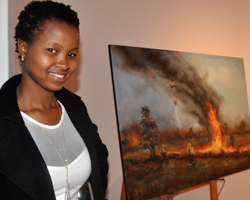
Fadzai Nyamusamba showing interest in the work: "Working on fire". This artwork was painted and donated by Mariette Pretorius, a professional artist from Bloemfontein. This art piece will be displayed at the South African National Disaster Management Centre in Pretoria.
Photo: Supplied |
The Disaster Management Training and Education Centre for Africa (DiMTEC) at our university, recently launched its Art on Disasters initiative at the Gallery on Leviseur in Bloemfontein.
Disasters have a devastating effect on societies and are accompanied by fear, uncertainties and often post-traumatic stress disorders. The creative arts have the ability to comfort survivors and those affected by tragedy. Amid disaster, art serves as a memorial, aids in the healing process and helps these communities to interpret their emotions.
This is precisely the main focus of the Art on Disasters project. It aims to develop paintings, sculptures, dramas, theatre productions, poetry and music in collaboration with artists. These productions will then be presented to communities at risk of, or affected by, disasters, to create awareness and foster healing.
Furthermore, the initiative will conduct research on art as a form of therapy and co-ordinate rehabilitation experts to assist the relevant communities. The artworks collected by the project, will be sold or auctioned to help raise funds. The proceeds will then be donated to a worthy cause as part of DiMTEC’s commitment to community service.
The project will help console and heal communities and aspire to generate greater resilience to trauma. It will also give humanitarian workers the opportunity to advocate for disaster risk reduction and offer them an opportunity for psychological debriefing after attending to affected communities.
“We will collect different categories of art related to all forms of disasters. These include paintings, photography, sculptures, poetry, music, theatre productions and short stories,” said Dr Andries Jordaan, Director of DiMTEC. “Stephanie Peters, Thomas Hart Benton, Tania Kovats and Medhi Naimi are just a few of the many artists that paint on man-made and natural disasters. They are artists that believe in art therapy as a form of self-expression, well-being and recovery,” he added.
For more information about this initiative, or to possibly contribute as an artist, please contact Olivia Kunguma from DiMTEC on +27(0)51 401 9699 or
kungumao@ufs.ac.za .